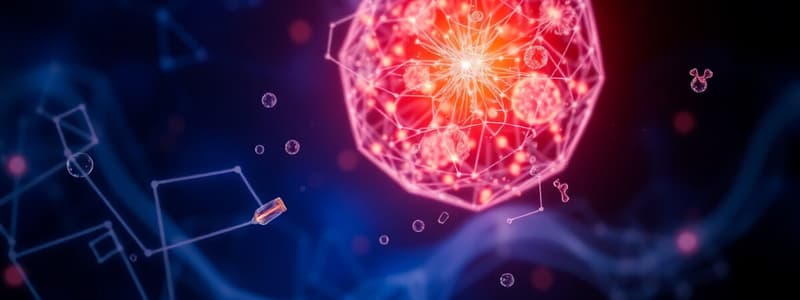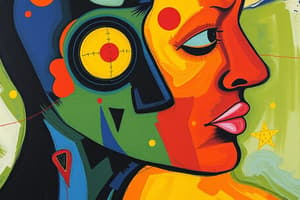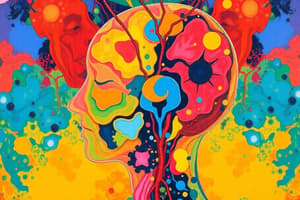Podcast
Questions and Answers
Which law suggests that we tend to fill in gaps to perceive whole objects?
Which law suggests that we tend to fill in gaps to perceive whole objects?
- Law of proximity
- Law of similarity
- Law of figure-ground
- Law of closure (correct)
What is perceptual constancy primarily concerned with?
What is perceptual constancy primarily concerned with?
- Seeing objects in color
- Understanding illusions
- Seeing objects consistently despite changes (correct)
- Recognizing facial features
Which phenomenon involves perceiving one visual feature as another, such as seeing two faces or a vase?
Which phenomenon involves perceiving one visual feature as another, such as seeing two faces or a vase?
- Ambiguous phenomenon (correct)
- Perceptual constancy
- Visual agnosia
- Depth perception
Depth perception allows us to estimate which of the following?
Depth perception allows us to estimate which of the following?
What distinguishes an illusion from a hallucination?
What distinguishes an illusion from a hallucination?
Which of the following describes visual agnosia?
Which of the following describes visual agnosia?
Which visual illusion involves a line appearing longer because of inward pointing arrowheads?
Which visual illusion involves a line appearing longer because of inward pointing arrowheads?
What is depth perception fundamental for?
What is depth perception fundamental for?
What is the principle that describes our tendency to group similar items together?
What is the principle that describes our tendency to group similar items together?
Which principle explains our perception of an object in relation to its background?
Which principle explains our perception of an object in relation to its background?
Which Gestalt principle suggests that elements close together in space are perceived as a group?
Which Gestalt principle suggests that elements close together in space are perceived as a group?
What does perceptual constancy allow us to do?
What does perceptual constancy allow us to do?
Which of the following best describes an 'ambiguous phenomenon' in perception?
Which of the following best describes an 'ambiguous phenomenon' in perception?
Depth perception primarily helps us to judge what?
Depth perception primarily helps us to judge what?
The Gestalt principle of continuity suggests that we perceive lines as:
The Gestalt principle of continuity suggests that we perceive lines as:
How do illusions differ from hallucinations in terms of perception?
How do illusions differ from hallucinations in terms of perception?
What does the Gestalt theory emphasize in perceptual organization?
What does the Gestalt theory emphasize in perceptual organization?
Which of the following best describes perceptual constancy?
Which of the following best describes perceptual constancy?
What characterizes an ambiguous phenomenon in perception?
What characterizes an ambiguous phenomenon in perception?
What does depth perception rely on?
What does depth perception rely on?
Which statement accurately differentiates between illusion and hallucination?
Which statement accurately differentiates between illusion and hallucination?
Which factor could influence changes in an individual's sensory thresholds?
Which factor could influence changes in an individual's sensory thresholds?
What is the role of selection in the perceptual process?
What is the role of selection in the perceptual process?
Which of the following best illustrates the principle of perceptual organization according to Gestalt theory?
Which of the following best illustrates the principle of perceptual organization according to Gestalt theory?
Flashcards are hidden until you start studying
Study Notes
Sensation and Perception
- Sensation is the process of acquiring information from our surroundings through our sensory receptors.
- Perception is the process of organizing and interpreting the sensory information we gather.
Absolute Threshold
- The absolute threshold is the minimum amount of stimulation needed for a person to detect a stimulus 50% of the time.
Difference Threshold
- The difference threshold is the amount of change needed for us to detect that a change has occurred.
- This change is referred to as the Just Noticeable Difference (JND).
How Sensation Occurs
- Sensory receptors, located in the eyes, ears, skin, nose, and tongue, receive and process information from the environment.
- These receptors convert the stimulus into neural impulses and transmit them to the brain.
Perceptual Process
- Selection of stimuli: The process of filtering information received by our senses.
- Organization: Collecting information into patterns or groups to assign meaning.
- Interpretation: Understanding and assigning meaning to the organized information based on past experiences, emotions, and opinions.
Factors Affecting Perception
- Motivation: Our needs and desires can influence what we perceive.
- Culture: Cultural background and experiences shape our perceptions.
- Expectations: Our prior experiences and beliefs influence how we interpret information.
Principles of Perceptual Organization (Gestalt Theory)
- The Gestalt theory emphasizes that the whole is greater than the sum of its parts, meaning perception is based on organizing parts into meaningful wholes.
5 Principles of Perceptual Organization
- Figure and ground: Distinguishing an object (figure) from its surroundings (ground).
- Gestalt principles of grouping: Organizing stimuli into meaningful groups.
- Similarity: Grouping similar items together based on color, shape, etc.
- Proximity: Grouping items close together in space or time.
- Continuity: Perceiving continuous figures rather than abrupt changes.
- Closure: Completing incomplete figures by mentally filling in gaps.
Perceptual Constancy
- Our ability to perceive objects as constant in size, shape, and brightness despite changes in the visual information received.
Depth Perception
- The ability to perceive the world in three dimensions, allowing us to estimate distances and navigate our environment.
Ambiguous Phenomenon
- Drawings where the figure and ground can be reversed.
- Our perception is typically stable, so we don't often see these reversals in everyday life.
Disturbance of Perception
- Illusions: Misinterpretation of sensory stimuli.
- Visual Illusions: Perceptual experiences differing from the actual stimulus.
- Muller-Lyer Illusion: A visual illusion where lines with arrowheads pointing inward appear longer than equal lines with outward-pointing arrowheads.
- Hallucinations: Imaginary sensations that do not exist in the external world.
- Visual Agnosia: Inability to recognize objects despite normal visual sensations.
- Prosopagnosia: Severe difficulty recognizing human faces.
Studying That Suits You
Use AI to generate personalized quizzes and flashcards to suit your learning preferences.




